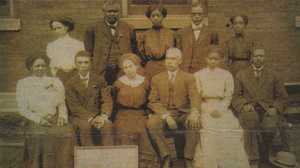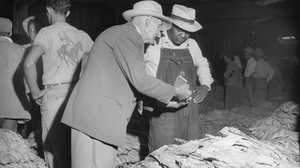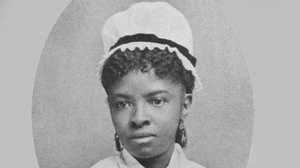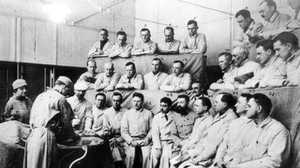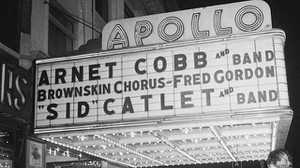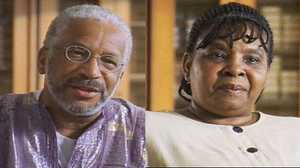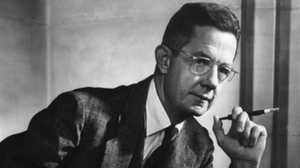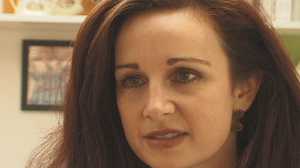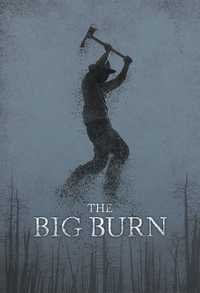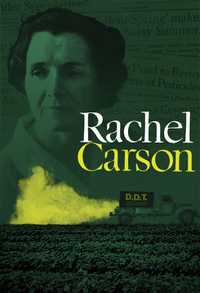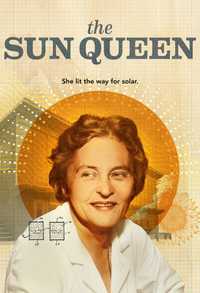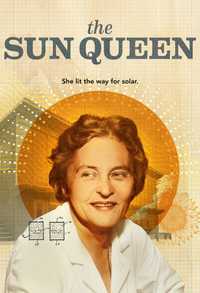NARRATOR: November, 1944. A surgeon dares to operate on the heart of a baby girl.
G. WAYNE MILLER, Author: Cardiac problems really was the Mt. Everest of surgery. It was a mountain that many thought couldn't be climbed.
NARRATOR: At stake were the lives of thousands of babies, doomed by a heart defect.
ROWENA SPENCER, M.D., Pediatric Surgeon: And to my dying day I will remember those poor squalling little babies, because they were so miserably uncomfortable.
NARRATOR: The surgeon held the scalpel, but another man was guiding him through the procedure. Together they would change the course of modern medicine. Alfred Blalock is remembered as a pioneer in cardiac surgery. At his side was Vivien Thomas. Thomas opened new paths for healing at a time when most doors were closed to him.
LEVI WATKINS JR.,M.D, Johns Hopkins: I think he is the most untalked about, unappreciated, unknown giant in the African American community. What he helped facilitate impacted people all over the world.
NARRATOR: Vivien Thomas and Alfred Blalock came from two different worlds. They first met in Nashville, Tennessee in 1930.
At 19 years old, Vivien Thomas had come of age in a world full of possibilities. He wanted to be a doctor, and in Black Nashville that was not a pipe dream. Nashville was a segregated town, but in some ways unlike other southern cities.
DR. BOBBY LOVETT, Historian: Well it was not a stereotypical black community in the South, because it did have a large elite class, with doctors and lawyers and storeowners and entrepreneurs and Nashville had a very large class.
NARRATOR: In the shadow of the state capital, most of Nashville's African American residents lived in poverty. But the residents of a middle class enclave created a world of their own. Black firemen secured the neighborhoods. Black doctors cared for the sick. And the churches were at the core of black life.
Nashville's economic boom had brought Thomas' father, a master carpenter, from Louisiana. The youngest of three sons, Vivien inherited his father's skill with his hands. Savings from carpentry jobs would be his ticket to college.
DR. BOBBY LOVETT: So if he had the skills and he had good education, he knew that in that segregated community he could make it as a doctor, as a teacher, as a lawyer, and so on.
NARRATOR: Thomas attended Pearl High School, where academic standards were high. An honors student in the class of 29, he planned to enter the Tennessee A&I State College that Fall. But soon after his graduation, the Great Depression struck Nashville. When banks failed, Thomas saw his savings for college -- seven years of carpentry work -- wiped out.
VIVIEN THOMAS (from autobiography): My first feelings were anger, followed by disbelief. Men were walking the streets for jobs that didn't exist. But I thought that things would somehow change in my favor.
NARRATOR: Across the tracks there was a job open at Vanderbilt University's medical school. Thomas was hired by Blalock, the director of the research laboratory, for pay less than a carpenter's wage. His job classification was janitor. Thomas' new boss was just 32 years old and had a reputation for hard work and a hair-trigger temper. Alfred Blalock came from old Southern aristocracy.
JOE MOORE, Historian: The Blalocks were always considered one of the best families in this region. And really making money came as natural to the Blalock men as breathing air.
NARRATOR: George Blalock ran a prosperous trading company and expected his son to carry on the family business. But Alfred had other ideas. He chose medicine. Then as a student at Johns Hopkins, he seemed more interested in sports and women.
ROBINSON BAKER, M.D., Johns Hopkins: He had a reputation as being very active socially. And at least in one group, which included my mother and some of her friends was called, Playboy Al.
NARRATOR: Denied a residency at Hopkins, Blalock ended up at Vanderbilt-in his view, the backwoods. But once he got to Nashville, the young doctor settled down. He met and married a debutante, Mary O'Brien. Their wedding was the social event of the year. At Vanderbilt, Blalock set an ambitious plan for the research lab. Eager to prove himself, he focused on one of the most misunderstood questions in medicine: What causes the body to go into shock? Each year surgeons lost more patients to shock than to any other single cause. Blalock needed help with his experiments. Within weeks after hiring young Thomas, he saw potential, someone he could train.
LEVI WATKINS, M.D.: I think he recognized early Vivien's talent, his technical talent, and what he needed was a technician.
ANDREW MANLOVE, Vanderbilt Technician: Blalock taught Vivien what to do. He taught him how to keep records. He would say, Vivien, what we need you to do is to write down what you're doing. You can't run an experiment without keeping an accurate record.
J. ALEX HALLER, M.D., Johns Hopkins: He learned very quickly how brilliant Vivien was and how talented because he turned over to him within a year's time the important responsibilities of taking all the notes on the experiments without him having any scientific background. What he couldn't have known was how unique that relationship would become.
LOUIS ROSENFELD, M.D, Vanderbilt University: Blalock was a stickler for perfection. If you did your work, he was wonderful to work with. But if you did not, he was hell warmed over.
VIVIEN THOMAS (from autobiography): One day, I became the target of Dr. Blalock's famous temper. The profanity he used would have made a sailor proud.
NAT CRIPPENS, Author: Vivien didn't say anything. But as he thought about it, a few minutes later, he said I don't have to take this.
VIVIEN THOMAS (from autobiography): I went across the hall to Dr. Blalock's office. I told him I had not been raised to take that kind of language. I was leaving.
NAT CRIPPENS: Dr. Blalock actually apologized to this 19 year old youngun. And he said, I'll never do that again. And Vivien said throughout the subsequent 34 years, Dr. Blalock never did that again to him. And that was the beginning of their mutual respect for each other.
JOHN EGERTON, Author: Down the road five or six years, they're a real team. He is an important research assistant to the doctor. But Vivien is still making a menial salary and he finds out he's still classified as a janitor.
NARRATOR: Thomas asked for a raise. His responsibilities were growing in the lab and at home. He was 24 years old and newly married. Thomas built his young bride a house. Now he needed to support a family.
ANDREW MANLOVE: That was one of the constant fights that he and Dr. Blalock had was salary. And he threatened to leave several times on that account. But Dr. Blalock always talked him into the notion of staying.
NARRATOR: When experiments forced them to work late, the two men would sometimes share a drink, discuss science, argue their points. In the privacy of the lab, they made the rules. Outside, the old rules remained.
JOHN EGERTON: In the eyes of Vivien Thomas, Vanderbilt had to look like a plantation. It was all white students. It was almost entirely white employees. And all of the black employees were in menial jobs. There were no exceptions to this, period.
NARRATOR: Thomas got a few token raises. But as long as he worked at Vanderbilt, he remained on the books a janitor. Blalock pushed for those small gains. He was anxious to keep Thomas and move his research forward.
LEVI WATKINS, M.D.: I think that was another thing that Blalock saw in him, inward drive. And just the ability to do whatever is necessary to accomplish what the laboratory was trying to do.
NARRATOR: Working side by side, the two men brought about a critical breakthrough -- they proved that shock was caused by the loss of blood and other fluids. This discovery would save millions of lives on the battlefields of World War II alone. Their success also brought their partnership to a crossroads.
JOHN EGERTON: When Blalock had an opportunity because of his growing renown to go elsewhere to teach and to move up in his professional life. He always made it a condition of any such consideration that Vivien Thomas came with the deal.
NARRATOR: In 1940, in one of their after hour talks, Blalock told Thomas that he'd received an exciting offer -- to return to Johns Hopkins as Chief of Surgery. Blalock asked his technician to go with him. LOUIS ROSENFELD, M.D.: Blalock realized he needed Vivien and I think Vivien debated about going with a wife and child.
VIVIEN THOMAS (from autobiography): I didn't know what to expect at Hopkins. It would mean leaving our community and the house that I had built with my own hands. But we were young and hoped that big things lay ahead.
ACT II
NARRATOR: The Thomases arrived in Baltimore in June, 1941. With war on the horizon, the city was jammed with thousands of new arrivals seeking jobs in its booming defense industries. The congested metropolis took the young couple by surprise.
CLARA THOMAS, Thomas' widow: I was ready to go back when I saw Baltimore. All I wanted to do was get out as fast as I came in. But it was something I had to put up with. And I put up with it.
NARRATOR: It wasn't just the big city atmosphere that upset them. If in going North Vivien and Clara Thomas had expected a more tolerant racial climate, they were quite mistaken.
FRASER SMITH, Author: It was really little different from the deep south. There were just as many exclusions for black people in the city of Baltimore as there were anywhere else. In some ways, they were, they were worse and more pronounced and divided.
VIVIEN THOMAS (from autobiography): The hunt for a place to live was disheartening. In Nashville we had a lawn and tress. Here such homes were "unavailable" to Negroes. Many apartments I looked at were hardly fit for human habitation.
NARRATOR: Thomas stayed with the Blalocks while he searched for a home. It took him several months to find a livable row house downtown. Only a few blocks away, dominating the neighborhood with its impressive dome, stood Johns Hopkins Hospital. Alfred Blalock's arrival as Surgeon-in-Chief was heralded in the local press. But his own department had mixed reactions.
JACOB HANDELSMAN,M.D., Johns Hopkins: He was held to be a person who was startlingly young. There was a serious question as to whether a person so young could run a department this important.
NARRATOR: Despite some internal opposition, Blalock set out to refocus the department on surgical research, largely neglected by his predecessor. The Old Hunterian Laboratory, removed from the main hospital building, would be the center of that effort. When the two men inspected their new workplace they were shocked by what they saw. The equipment was outmoded at best; one lab looked abandoned.
VIVIEN THOMAS (from autobiography): I was not prepared for the odor that greeted us when we entered. The main laboratory was a mess. The atmosphere throughout was depressing...almost revolting. So this is Johns Hopkins. The great Johns Hopkins I have been hearing about for as long as I can remember.
NARRATOR: Together, Blalock and Thomas faced the challenge of building a new research facility. On his own, Thomas confronted a much deeper issue.
FRASER SMITH: Well, Hopkins was regarded as prejudiced. That was the word that was used in those days; that they were a sort of an implacable fortress.
LEVI WATKINS, M.D.: The black community, with reason, had no faith and no trust in this institution. And it's because of the legacy of separation and segregation. The legacy of coming into this hospital and seeing your color only in the basement.
NARRATOR: In 1941, all of Johns Hopkins' facilities were segregated. There was also a rigid hierarchy among the medical staff.
KOCO EATON, M.D., Thomas' Nephew: Hopkins is a university and medical school that's very, very deep in tradition. And the way you dress and the particular clothes that you're wearing lets everyone know what your position in life is at that school. The interns wear a short white coat and white pants. When you graduate to the level of a senior resident, then you can wear your own pants. And you wear a long white lab coat.
NARRATOR: As a technician in Blalock's research department, Vivien Thomas also wore a white lab coat.
RICHARD SCOTT, M.D. Cardiovascular Surgeon: When he wasn't scrubbed, he had on the most immaculate white lab coat that I had ever seen. I mean -- and it was just -- there were no wrinkles. It was just starched to the ultimate.
NARRATOR: One memorable day Thomas left the Hunterian lab and walked to the Main hospital building.
FRASER SMITH: Vivien would have been seen as quite an anomaly. Walking down the hallway, people would have wondered what -- who is this person. How is he here? Who let him in?
KOCO EATON, M.D.: And he said there was such a big stink raised about it. People wanted him fired. So actually Blalock had a talk with him and said 'Listen, when you go over to the hospital, take your lab coat off.' He was a man with pride, but yet a lot of times that pride couldn't show. So I think it was very tough for him.
ROBINSON BAKER. M.D.: Dr. Blalock was not opposed to segregation and he had the same attitudes about race, I think, as anyone else raised in Southern Georgia. When he came to Baltimore those attitudes really weren't much different. This was a very segregated hospital. Not much was said or done about it at the time.
NARRATOR: Blalock was preoccupied with his search for a major new project. In the fall of 1943 he was approached by a colleague with an intriguing idea. Her name was Helen Taussig.
J. ALEX HALLER JR., M.D.: Dr. Taussig was the first woman pediatric cardiologist. She was one of the first women on any faculty anywhere. When she was made chief of pediatric cardiology, her great concern was with congenital heart disease in children.
NARRATOR: Helen Taussig was practically deaf from a childhood bout with whooping cough. In spite of this, she could diagnose complex heart anomalies using a special stethoscope and her hands. Taussig was deeply touched by children afflicted with a deadly heart defect. She called them her "Blue Babies." Cookie Belkov was one of them.
SYLVIA BELKOV, Cookie's mother: She had blue lips, blue fingers, and blue feet. You would sit her down and she would sit just like this -- she didn't look alive. Because we sat her in the grocery store one day and a little boy walked in and all of a sudden, he started screaming. And his mother said what's the matter? He said the doll that's sitting there -- her eyes move and so do her hands. Cookie looked like a living doll.
NARRATOR: Cookie's heart was failing; so were her lungs. This stunted her growth and gave her skin a peculiar blue cast. Taking just a few steps left her gasping for breath. Medical science had no treatment. Cookie's prognosis was grim.
SYLVIA BELKOV: They had no options. Babies like that are supposed to die. See I couldn't absorb it. Maybe I didn't want to.
NARRATOR: Thousands of Blue Babies were born every year. Their frightened parents were desperate for a cure. But any solution would involve physically altering the human heart.
G. WAYNE MILLER: Historically, the heart was considered taboo. Medically intervening in any way, certainly cutting it was something that could not be achieved, would simply be impossible.
NARRATOR: Taussig had a daring idea to create a pathway from the heart to the lungs using an artery. She shared this thought with Blalock. Despite advances in surgery, no one had ever attempted such a complex procedure. Blalock accepted the challenge. Over the next year, he and Thomas explored the dilemma in the now renovated Hunterian Laboratory. Their collaboration took on a new urgency. The lives of children like Cookie Belkov would depend on their success.
G. WAYNE MILLER: They came up with a very ingenious idea of connecting an artery that sent blood out into the body to an artery that brings blood into the lungs. By doing that, they added significantly more oxygen to the blood.
NARRATOR: Blalock, tied up with teaching and administrative chores, left the details of the procedure to Thomas. When they found that surgical instruments they needed didn't exist, Thomas made them himself. Later, these would become standard in the operating room.
J. ALEX HALLER JR., M.D.: Vivien designed these instruments and then Dr. Blalock would get one of the medical companies to actually manufacture them based upon Vivien's feeling about what technically was going to be the most useful. NARRATOR: The toughest challenge would be to duplicate the blue baby syndrome in laboratory animals. First Thomas had to create the defect in a dog before they could correct it.
NEWSREEL NARRATOR: Her pedigree isn't royal, but thanks to Anna and the surgeons at Johns Hopkins, thousands of our children may have a new lease on life!
NARRATOR: Anna is the only animal whose portrait hangs in the Hopkins medical library. With Anna, Thomas and Blalock had solved the technical problems. Now the big question remained. Would the procedure work on a gravely ill child? In the Autumn of 1944, Taussig asked Blalock about saving a critically ill baby. Her name was Eileen Saxon.
DENTON COOLEY, M.D., Texas Heart Institute: You know, the real worry at the time was could a little blue child like this withstand surgery? And withstand anesthesia?
NARRATOR: Eileen Saxon was dying. There was no time left. Overnight, the team would move from the laboratory to the operating room. Just under nine pounds, Eileen's fragile condition was of great concern. When the anesthesiologist saw her, he quit, convinced that she could not possibly survive.
WILLIAM LONGMIRE, M.D., UCLA: Everyone was predicting it was gonna be a disaster. It satisfied me that we were gonna make a desperate effort to save this child's life.
NARRATOR: On the morning of November 29th, 1944, Eileen Saxon was wheeled into the operating room. All those present knew this was not just another day on the job. They were now characters in a larger drama. At 8:00 AM, Dr. Blalock was prepared for surgery. In the gallery, a small group of observers waited anxiously. Someone was missing. "Where is Vivien?" He bellowed. "Go get him."
DENTON A. COOLEY, M.D.: I knew that he felt rather insecure by not having Vivien there because Vivien had probably more experience with doing these procedures than Dr. Blalock had.
NARRATOR: At Blalock's insistence, Vivien Thomas stood on a step stool just behind him. Thomas had done the operation hundreds of times on laboratory animals. At Hopkins, Blalock had performed the entire procedure just once.
G. WAYNE MILLER: He was going where no one had gone before. And he was going within an area where there were great consequences to failure. The consequence was you had a dead baby.
NARRATOR: Eileen was so very small; It was difficult to tell there was anything beneath the sterile drapes.
G. WAYNE MILLER: Surgery by today's terms certainly was Neanderthal. You had no way to get an instant report on what was happening inside the body. Among the most sophisticated equipment [in the OR] would have been the clock. Blalock didn't have unlimited opportunity inside the body. He had to keep a clear eye on the clock and what was going on. I mean, this was really flying blind.
NARRATOR: Ninety minutes had elapsed. Blalock began to sew up Eileen's tiny arteries, no thicker than a matchstick. Vivien Thomas' voice could be heard quietly guiding him through the procedure.
The two men stood elbow to elbow with a single focus on the operating table. Two men who could not share the same lunch table in the Hopkins cafeteria.
VIVIEN THOMAS (from autobiography): Until the bulldog clamps were removed, I had no idea if those sutures would hold. But when they came off, there was practically no bleeding. You have never seen anything so dramatic. It was almost a miracle.
WILLIAM LONGMIRE, M.D.: Dr. Blalock had to stop and take a look over the screen to see how quickly -- how beautifully -- this red color had come to this child's lips.
DENTON A. COOLEY, M.D.: Dr. Taussig was at the head of the table there. And she said, 'Al, the baby's lips are a glorious pink color.'
ALAN C. WOODS JR., M.D., Johns Hopkins: I can't even talk about that day without emotion. Everybody was around and everybody was crying.
ACT III
NARRATOR: Little Eileen Saxon offered the first ray of hope to parents of thousands of blue babies.
"BLUE BABY MIRACLE" NEWSREEL
G. WAYNE MILLER: The popular press immediately seized hold of this and the word miracle was used repeatedly. And it was a big story. I mean it was a story on, on the level of mapping the genome today.
NARRATOR: News of the operation's success brought a flood of desperate parents to Johns Hopkins' doors.
RAY HEIMBECKER M.D. OC, University of Western Ontario: The Blue Baby operation put Johns Hopkins on the map. We had people coming in from all over North America. Every day there would be license plates from Tennessee, from Quebec, from Alaska. People bringing their sickly children to us for help.
NARRATOR: Not every child could be saved. Eileen Saxon, the first Blue Baby, died from complications within a year after her operation. The new surgery, still experimental, was used only on children with no other hope for survival. Cookie Belkov was now four years old, her condition much worse.
SYLVIA BELKOV: Cookie had 4 spells in one day. I called my doctor. He says we're not putting it off. I'm calling Johns Hopkins. Next thing I knew, he says, pack up, you're getting on a train. You and Cookie.
NARRATOR: Cookie was rushed to Hopkins, her condition so serious that Blalock cancelled a trip to Europe to operate immediately. Her operation lasted two hours, but it would be nine hours before Sylvia Belkov knew the results.
SYLVIA BELKOV: I did not see Dr. Blalock until they brought her into her room. And he says, you want to see your daughter, go ahead. She looked like a little rosebud. She was beautiful when they brought her down, just beautiful. I'll tell you the color pink is prettier than the color blue.
NARRATOR: Cookie Belkov was one of the early success stories. Today, she lives in San Francisco.
The Hopkins Heart room had captured world attention. Michelle Rannou flew from Paris clutching her life-sized doll. One mother hitchhiked with her two year old from Appalachia. American GIs stationed in Germany, raised over $2000 to send a 5 year old from Frankfurt. Under the intense spotlight of the O.R., Blalock and Thomas perfected their procedure. During the first year alone, the team performed over 200 operations.
WILLIAM GROSE M.D., Johns Hopkins: Dr. Blalock's major attribute as a surgeon was that he wouldn't quit. And I've seen him when he would be suddenly confronted with the kind of thing where surgeons would be tempted to literally throw in the towel and he wouldn't. He'd never give up.
NARRATOR: In the first six months, there would be many tense moments in the O.R. Often, Blalock called on Thomas for support. He would tell anyone who moved into the space behind his right shoulder, "Only Vivien is to stand there."
ROWENA SPENCER, M.D.: He depended on Vivien for advice about how long to make the incision and how many stitches. And occasionally Vivien would say, Dr. Blalock, put that stitch in the other way.
J. ALEX HALLER JR., M.D.: They depended upon each other and knew the other's important strengths and roles and they simply leaned on each other.
NARRATOR: What began as a medical sensation, two years later became a routine procedure. Blalock welcomed scores of surgeons to Hopkins to observe the operation.
JACOB HANDELSMAN, M.D.: It became the most famous department of surgery in the world. The number of people who wanted to train here were huge in number.
NARRATOR: The Department of Surgery grew, and Thomas was given new responsibilities.
RICHARD SCOTT, M.D.: As the director, essentially, of the surgical research laboratory, he was given an awful lot of authority to train surgeons and these were individuals that were handpicked by Dr. Blalock.
NARRATOR: Every surgeon in training was required to study surgical technique with Thomas.
J. ALEX HALLER JR., M.D.: One of the things that was so important about Vivien's teaching was that he broke down complicated operations into simple steps. And that way you could teach it to anybody -- even me.
NARRATOR: Alex Haller would later become chief of Pediatric Surgery at Johns Hopkins. In her last year of medical school, Rowena Spencer became Thomas' assistant.
ROWENA SPENCER, M.D.: Many times in my career I was complimented on my surgical technique and I will admit that a good many people were shocked when I told them I learned my surgical technique from a black man who had only a high school education.
NARRATOR: Thomas was teaching surgery to the country's brightest young doctors, but outside the hospital, his status changed. When Blalock entertained his staff at home, Vivien was with them. But not as a guest. DENTON A. COOLEY, M.D.: One of his responsibilities it seemed was to serve as a bartender at our functions. Vivien was there, he was behind the bar.
NARRATOR: Still struggling to earn a decent living, Thomas moonlighted as a bartender to make ends meet.
RICHARD SCOTT, M.D.: That put him into a strange scenario whereby he was training individuals during the day and then serving them their drinks at night.
WILLIAM GROSE, M.D.: I don't think any of us realized how bizarre it was to have a person of his talents waiting tables or waiting the bar. But nobody thought the less of him for doing it. He was as nice as he was good. He was just a heck of a nice guy, a heck of a nice guy.
LEVI WATKINS JR., M.D.: Vivien was not a coequal by any stretch of the imagination. So I think the gentlemen both were products of their time. And in an incredible way, complemented each other. But at the same time, kept the constraints.
NARRATOR: In the corridors of Hopkins, Thomas had attained respect, but few outside knew his importance. He received a substantial raise, but his life-long dream eluded him.
RICHARD SCOTT, M.D.: He was very confident that he had what it took to become a physician. And he had all of these surgical skills and he was in sort of a real mid-life crisis.
NARRATOR: In the fall of 1947, approaching 40, Vivien Thomas went to nearby Morgan State to enroll as a freshman. To become a doctor, he would first need to earn a Bachelor's degree, then complete medical school and spend four years as a resident. By the time he entered practice, he would be past 50 years old.
GWEN MANLOVE CLARK, Family friend: He had family and children. He knew that he was going to have to let the dream of going back to college go. And that hurt, that was very crushing.
ANDREW MANLOVE: Vivien wanted to be a doctor. He loved to do research. But that was as close to being a doctor as he could get.
NARRATOR: In April 1960, Alfred Blalock celebrated another milestone.
BETTY BLALOCK, Blalock's daughter: The 60th birthday was a grand affair. It was attended by people - doctors from all over the world.
NARRATOR: The party was held at Baltimore's Southern Hotel, which for over 40 years reined as the city's finest. As the champagne flowed, friends and colleagues gathered to toast the dean of American Surgeons.
ALFRED BLALOCK, M.D. (from text of speech): "The sky was never so blue, and the grass so green as they are this day for me. These are my sentiments tonight."
NARRATOR: More than 500 people were invited to the gala. But Vivien Thomas was not on the guest list. Friends secretly arranged for Thomas to watch the festivities -- from the back of the ballroom. Like all of the city's hotels and restaurants, the Southern Hotel was still segregated. A black man did not walk through its front door.
But the restrictions of the past were being challenged. In Baltimore, blacks moved beyond the boundaries of segregated neighborhoods. Elsewhere, freedom riders and protests signaled a nationwide change. By 1964, Johns Hopkins had taken its first steps towards desegregation. Wards and staff cafeterias became integrated just as Alfred Blalock was retiring.
[APPLAUSE]
BETTY BLALOCK: He was in very bad shape. Very - actually they, I don't think they knew what was the matter with him and they were treating him for a bad back problem. And it turned out he really had cancer.
ALFRED BLALOCK, M.D. (Archival footage): "Unlike Mayor McKeldin, I fell into the hands of surgeons. [LAUGHTER] And I hope next time I'll have asthma."
ALAN C. WOODS JR., M.D.: He was one wonderful man. I don't know anybody who worked for him who wouldn't have taken off his right hand and given it to Dr. Blalock if Dr. Blalock had asked him to. Particularly all the left handed guys.
NARRATOR: They called themselves the Old Hands Club, an Association of Blalock's former residents. By the mid-1960's they were heading up the surgery departments at the nation's leading hospitals, and were pioneering the field's next dramatic advances: open heart surgery and heart transplants.
DANDY BLALOCK, Blalock's son: He was a supreme teacher and that was his joy. More than the awards. That was not what he was really going for at all.
BETTY BLALOCK (OC): But they didn't hurt.
NARRATOR: This would be Blalock's last public appearance. He died four months later at age 65. Vivien Thomas had lost his friend and colleague of 34 years.
VIVIEN THOMAS(from autobiography): It was so unfortunate that his time was cut off. His mind was still so keen on research. We fought all the time but I think we both thrived on it.
RICHARD SCOTT, M.D.: Mr. Thomas was a very young man at that time. So he had a lot of living to do. And there was a lot of uncertainty as to which direction his career would go into. And I think he had a very unique bond with Dr. Blalock and perhaps he believed this could not be achieved with any other individual.
NARRATOR: Vivien Thomas fell into a depression. For six years he did not undertake a major research project. Then he made a new connection. Drawing on his own experience, he began to guide the first generation of African Americans through the ways of Hopkins. To these young students, he offered a vision of what they could be. He became more than a teacher, he became a mentor.
RICHARD SCOTT, M.D.: He was my initial supporter. It was a result of his encouragement that I was able to persevere in some of my career choices.
NARRATOR: The choices for the next generation were different from those Thomas had faced as a young man.
LEVI WATKINS JR., M.D.: We were from different eras. He was in the 40s, I was in the 50s and 60s. I had been exposed to Dr. King and the whole civil rights movement. I was looking at what was happening at Hopkins, which was not too different from Alabama, to be honest. And so I was getting outspoken about what we should do about black medical students, interns, residents, faculty, so forth. And in a fatherly fashion, he just wanted me to be cool. And wait for the appropriate times.
NARRATOR: One February morning in 1971, a large group gathered in an auditorium at the Hopkins medical school.
GWEN MANLOVE CLARK, Family friend: And I was trying to sense what was about to happen. There was a sort of positive tension in the room. And they had told us, just matter of factly, we want you to go over to Johns Hopkins with us and something is going to happen; They're going to make a little presentation and we got over there, and Vivien's the key person. He's in the spotlight.
NARRATOR: Vivien Thomas stood at center stage for the first time. The members of Blalock's Old Hands Club had commissioned his portrait. They came from all over the country to pay tribute to him.
J. ALEX HALLER JR., M.D.: We felt very strongly that Vivien should be hanging on the wall just as some of the other great surgeons in the Hopkins tradition and when I presented that to Vivien, he said oh, no, that's not appropriate. And I said it's very appropriate and all of us who have trained here feel that you should be hanging on the wall like these other surgical greats.
RICHARD SCOTT, M.D.: This was a true recognition, a true recognition by his peers of, of his fantastic contributions to cardiac surgery.
VIVIEN THOMAS (text from speech): People in my category are not accustomed to being in the limelight as most of you are. Being placed in the position I find myself now makes me feel quite humble. But at the same time, just a little proud.
VALERIA SPANN, Thomas' niece: And I tried to pull back and see whom this person really was that I called Uncle V. It was seeing him in a new light and I was just a little speechless and I told him that. That, you know, I just -- I was speechless knowing that he had done something of such great importance.
NARRATOR: Reporters sought him out in the lab and articles appeared in the local press. Nearing 60, Vivien Thomas began to receive the public recognition that for so long eluded him.
Graduation Day, May, 1976. Vivien Thomas received an honorary doctorate. At the presentation, he was called "a man in the finest tradition of medicine at Johns Hopkins."
KOCO EATON, M.D.: Vivien was very proud of the doctorate that he received. And I remember looking at it and thinking, why is it a doctorate of law? Why didn't they give you a doctorate of medicine? And he explained to me that they're not allowed to give honorary doctorates of medicine, that they could only give him a doctorate of law. So he has an honorary degree in a doctorate of law from Johns Hopkins.
NARRATOR: After 37 years at Hopkins, Thomas was officially recognized as a teacher and was appointed to the medical school faculty.
ROWENA SPENCER, M.D.: I only went back to Baltimore once and the only person I was interested in seeing was Vivien. And by this time he had an office in the hospital I guess it was. Perhaps in the medical school building. And when I walked into his office, he was sitting there behind his desk and I wasn't sure he'd remember me. But he did. He saw me, and he got up and came around the desk and said Rowena! And gave me a big hug. Makes me a little tearful. Isn't that silly?
When I went back for my reunion, the only portrait I wanted to see was Vivien and the minute I saw him, I burst into tears.
NARRATOR: Vivien Thomas retired in 1979. That same year, Levi Watkins joined the medical school admissions committee. Within four years, minority enrollment quadrupled. Thomas took great satisfaction in seeing the number of black medical students increase. His nephew Koco Eaton entered Hopkins in 1983.
KOCO EATON, M.D.: I was a medical student and went over to Vivien's house [for dinner]. His health wasn't good and he had suffered a stroke. And it seemed like as, as I was entering into his world, he was passing out of it. And I was looking from inside of his world, as he is sitting on the outside -- wanting to bring him back in and really just question him as to how'd you do this, would you do that, where'd this idea come from? And I just really had a million and one questions for him of, you know, this type of technique, that type of technique. I mean, now that I knew, I knew what to ask him. Now I knew an appreciation for him and he was gone.
NARRATOR: Vivien Thomas died at the age of 75. Just days later, his autobiography was published. It described his life's work with Alfred Blalock.
VALERIA SPANN: I'm sure he recognized that he had done something so important for mankind. And whether he boasted about it or not, he recognized it. I'm sure.
LEVI WATKINS JR., M.D.: I think the implications are extraordinary. Take a man like this, without much formal anything, that impacts on inventions, and also impacts on the nation's premiere heart surgeons, I look at him as a global person that rose above the conditions of his time.
Title Card Dissolves up.
Dr. Blalock examined the incision. He asked, "Vivien are you sure you did this?"
"This looks like something the Lord made." Vivien T. Thomas
Excerpted from his autobiography, Partners of the Heart: Vivien Thomas and His Work with Alfred Blalock.
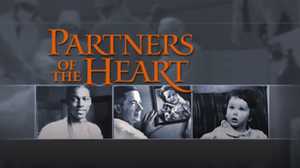
 In November 1944, a critically ill 15-month-old, weighing just nine pounds, was wheeled into the operating room. Cardiac surgeon Dr. Denton Cooley recalls, "The real worry was could a little blue child like this withstand surgery?" With Thomas at his side, directing his every move, Blalock embarked on a desperate attempt to save Eileen Saxon. It was the first time he had performed this operation outside the laboratory.
In November 1944, a critically ill 15-month-old, weighing just nine pounds, was wheeled into the operating room. Cardiac surgeon Dr. Denton Cooley recalls, "The real worry was could a little blue child like this withstand surgery?" With Thomas at his side, directing his every move, Blalock embarked on a desperate attempt to save Eileen Saxon. It was the first time he had performed this operation outside the laboratory.